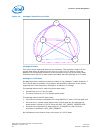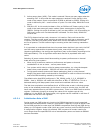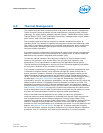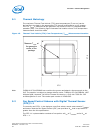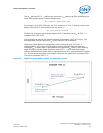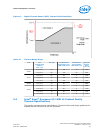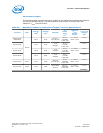
4.3.4 DDR Electrical Power Gating (EPG)
The DDR I/O of the processor supports Electrical Power Gating (DDR-EPG) while the
processor is at C3 or deeper power state.
In C3 or deeper power state, the processor internally gates V
DDQ
for the majority of
the logic to reduce idle power while keeping all critical DDR pins such as
SM_DRAMRST#, CKE and VREF in the appropriate state.
In C7, the processor internally gates V
CCIO_TERM
for all non-critical state to reduce idle
power.
In S3 or C-state transitions, the DDR does not go through training mode and will
restore the previous training information.
4.4 PCI Express* Power Management
• Active power management is supported using L0s, and L1 states.
• All inputs and outputs disabled in L2/L3 Ready state.
4.5 Direct Media Interface (DMI) Power Management
Active power management is supported using L0s/L1 state.
4.6
Graphics Power Management
4.6.1 Intel
®
Rapid Memory Power Management (Intel
®
RMPM)
Intel Rapid Memory Power Management (Intel RMPM) conditionally places memory
into self-refresh when the processor is in package C3 or deeper power state to allow
the system to remain in the lower power states longer for memory not reserved for
graphics memory. Intel RMPM functionality depends on graphics/display state
(relevant only when processor graphics is being used), as well as memory traffic
patterns generated by other connected I/O devices.
4.6.2
Graphics Render C-State
Render C-state (RC6) is a technique designed to optimize the average power to the
graphics render engine during times of idleness. RC6 is entered when the graphics
render engine, blitter engine, and the video engine have no workload being currently
worked on and no outstanding graphics memory transactions. When the idleness
condition is met, the processor graphics will program the graphics render engine
internal power rail into a low voltage state.
4.6.3
Intel
®
Graphics Dynamic Frequency
Intel Graphics Dynamic Frequency Technology is the ability of the processor and
graphics cores to opportunistically increase frequency and/or voltage above the
guaranteed processor and graphics frequency for the given part. Intel Graphics
Dynamic Frequency Technology is a performance feature that makes use of unused
package power and thermals to increase application performance. The increase in
frequency is determined by how much power and thermal budget is available in the
Power Management—Processor
Intel
®
Xeon
®
Processor E3-1200 v3 Product Family
June 2013 Datasheet – Volume 1 of 2
Order No.: 328907-001 61






